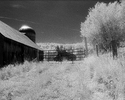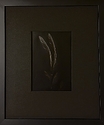I'm away from home this week and in a home without photo-chemicals to hand (although we did find a half empty bottle of Rodinal from about 1983 that blackens film still  ).
).
there's a small treasure-trove of vintage cameras and (very vintage) film and (extremely vintage) paper found here too, and it would have been fun to shoot a few rolls and sheets and see what it all looked like ... but of course I didn't think to bring proper fixer
So I wondered what I could do in a pinch to fix film ... if one is NOT worried about maintaining best quality or archival stability of course ... yes I know, we could always go to a pool supplier and buy hypo (except in the depths of rural Wales there are no such things as "pool suppliers", let alone anything resembling a camera shop) ...
We know that a saturated solution of table salt will fix film - sloooooooowly
I happen to have some Ammonium thiocyanate with me (for playing with fixing lumen prints), which I think is used in some colour blixes, as well as a part of the Chromoskedasic process (I'll try that too one day) and a test with a scrap of film showed a solution cleared it within a few minutes.
So I wondered what a suitable solution ratio for thiocyanate might be for fixing b&w film ... 2½% or so perhaps?
I seem to remember reading that ammonia will do something to developed film ... but I can't remember whether it fixes it or strips the emulsion off
It'll all keep 'til I get home again of course, and there are runner beans to pick and the dog to walk, so this is just me being idly curious about what one can find under the kitchen sink to fix fillum
 ).
). there's a small treasure-trove of vintage cameras and (very vintage) film and (extremely vintage) paper found here too, and it would have been fun to shoot a few rolls and sheets and see what it all looked like ... but of course I didn't think to bring proper fixer
So I wondered what I could do in a pinch to fix film ... if one is NOT worried about maintaining best quality or archival stability of course ... yes I know, we could always go to a pool supplier and buy hypo (except in the depths of rural Wales there are no such things as "pool suppliers", let alone anything resembling a camera shop) ...
We know that a saturated solution of table salt will fix film - sloooooooowly
I happen to have some Ammonium thiocyanate with me (for playing with fixing lumen prints), which I think is used in some colour blixes, as well as a part of the Chromoskedasic process (I'll try that too one day) and a test with a scrap of film showed a solution cleared it within a few minutes.
So I wondered what a suitable solution ratio for thiocyanate might be for fixing b&w film ... 2½% or so perhaps?
I seem to remember reading that ammonia will do something to developed film ... but I can't remember whether it fixes it or strips the emulsion off

It'll all keep 'til I get home again of course, and there are runner beans to pick and the dog to walk, so this is just me being idly curious about what one can find under the kitchen sink to fix fillum






